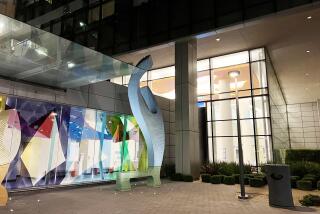The Mystery of RSD
A 21-year-old ballerina and actress with aspirations of a show business career, Cynthia Toussaint was stretching on a ballet barre when she felt a sharp pain in her right leg.
Doctors told her it was a torn hamstring--a common injury for dancers--that would heal with time and rest. But as weeks passed, the pain didn’t ease; it grew steadily worse.
She didn’t know it at the time, but Toussaint would see her injury result in a devastating illness that would end her dreams of a career in the spotlight and, eventually, leave her disabled and mostly relying on a wheelchair. It also began a harrowing 15-year encounter with a medical community that often fails to properly diagnose and treat a little-known illness.
“I had this wonderful life planned,” says Toussaint, of North Hollywood. “After I got sick, I was left in this constant, horrible pain, and I knew it was all over.”
Doctors say Toussaint has a little-understood and controversial medical condition commonly known as reflex sympathetic dystrophy, or RSD. Recently, doctors who specialize in treating RSD have begun describing it by various other names, including “complex regional pain syndrome, type 1.”
The new name reflects still-evolving research into the condition--originally described in the 1860s--and its causes, diagnosis and treatment. As research progresses, there is still significant disagreement within the medical community about how to diagnose the illness since there is no single diagnostic test that proves a person has RSD.
RSD is “definitely under-diagnosed because it’s still not well-known” by the medical community, says Dr. Joshua Prager, a Santa Monica anesthesiologist and former director of the UCLA Pain Medicine Center. “This condition was described in vivid detail 130 years ago, but for some reason it’s still not taught in medical schools.”
*
The condition often begins with an injury, as minor as a sprained ankle, or as traumatic as a broken leg. An early warning sign of RSD is pain that doesn’t go away and is more severe than would be expected from the injury.
“There is an unbelievably dreadful burning pain and heat associated with this condition,” says Dr. Michael D. Stanton-Hicks, an RSD specialist who heads the pain center at the Cleveland Clinic in Ohio. Swelling, unusual hair and nail growth, and changes in skin temperature and texture near the site of the injury are some of the other symptoms.
One of the many mysteries of the disease is how a relatively minor injury can touch off a devastating illness in some people but not in others. A few researchers believe some people may have a genetic predisposition to RSD, but there is scant research on the point.
“Why do some people get RSD and others don’t?” asks Prager. “That’s the $64,000 question that current research is trying to answer.”
When diagnosed early and treated aggressively, RSD is often put into remission, medical experts say. Left untreated for several months or longer, however, and the likelihood of successful treatment falls off sharply.
In severe cases, RSD patients suffer intractable pain that leaves them bedridden. They are unable to tolerate the slightest touch; even being covered by a bedsheet is excruciatingly painful. Muscles and joints waste away, immune systems weaken, and arms and legs go into disfiguring contractures.
Many RSD sufferers find it impossible to hold jobs or perform everyday tasks such as cooking. The impact on their social lives “can be devastating and can break up families,” says Stanton-Hicks.
Many patients must battle bouts of depression that occasionally end in suicide. As if their physical problems weren’t bad enough, RSD patients also must cope with barriers to care within the medical system.
RSD patients describe years of being bounced between specialists without a diagnosis or useful treatment, experts say. When patients finally do find a doctor familiar with the disease, their condition often has deteriorated to the point at which treatment is difficult, expensive and ineffective. This leaves patients angry and distrustful of the medical system, experts say.
“I’ve had some patients who have seen 20 doctors,” says Dr. Edward Carden, a pain specialist at Centinela Hospital Medical Center in Inglewood. Many patients are seen by orthopedists, “who do a nerve conduction study that appears to be perfectly normal. Then they’ll tell the patient: ‘Go see a psychiatrist.’ ”
RSD patients often complain of poor treatment by doctors who are not well informed about the illness and often too quick to dismiss their complaints of pain as imagined.
“Patients often are not believed by their doctors and others that their pain is real,” says Alfie Burns, co-founder of the RSD Assn. of California. In 1984, Burns was pushing her son’s stroller when she stepped on a stone and bruised her foot, sparking an explosion of pain that eventually put her in a wheelchair. It wasn’t until 1988 that doctors diagnosed the problem as RSD.
*
Toussaint knows all too well about the problems of getting a diagnosis for the condition. She was a patient at Kaiser Permanente from the time of her injury in 1982 until this past December.
Toussaint contends that a series of Kaiser doctors failed to diagnose her condition as RSD after her hamstring injury. Because experts agree that early diagnosis is crucial, Toussaint claims that the delay caused her condition to steadily deteriorate to the point at which she was virtually bedridden.
She remained in the Kaiser health plan for so long, she says, because other insurers denied her coverage because of her preexisting medical condition. Toussaint, who is pressing a malpractice claim against Kaiser through private arbitration, says Kaiser doctors early on labeled her condition as psychosomatic, saying that she was making it up, that she didn’t want to get well or had “tendinitis from Mars.”
One non-Kaiser doctor in the late 1980s concluded that she might have RSD, Toussaint says. But when his initial treatment of the condition had little impact, both Toussaint and the doctor began to question that diagnosis. Her Kaiser internist, she says, never mentioned the possibility of RSD to her or her family until 1995. But in March 1996, that internist, Dr. Shanthi Suresh, wrote in a letter for a disability insurance review that Toussaint “suffered from severe generalized pain syndrome with a working diagnosis of possible reflex sympathetic dystrophy.”
In an interview, Dr. Joel Hyatt, a Kaiser medical executive, said Suresh “tried not to use the word ‘RSD’ ” in conversations with Toussaint and “made it very clear many, many times” that she did not have RSD. Suresh’s 1996 statement about a “possible” RSD diagnosis, he said, “might have been a mistake.”
Hyatt says a diagnostic nerve-conduction test was conducted at Kaiser in 1988 that “disproved” RSD. And the giant HMO also has provided Toussaint with “exhaustive diagnostic tests . . . and psychiatric therapy,” he says.
Kaiser contends that Toussaint suffers from “chronic pain syndrome” but that her physical symptoms have a “significant psychological component.”
Steven J. Weinberg, a Palm Desert attorney representing Toussaint, says of Kaiser’s contention: “That’s as much an insult to Cynthia as Kaiser’s lack of treatment. Here’s an articulate, intelligent woman who definitely is not a head case, and RSD is not psychosomatic but a real and very painful illness.”
*
Pain specialists say they frequently hear complaints from chronic-pain patients enrolled in HMOs about a lack of treatment.
“I see cases that come from HMOs where the doctors either didn’t understand this or didn’t want to treat them,” says Prager. “Patients wallow in those systems for years, and nobody does anything.”
Experts disagree on the extent to which psychological rather than physical factors play a role in this condition. This debate is hampered by a lack of scientific evidence on both sides.
Prager recalls only two patients out of hundreds he has treated who had “factitious” RSD--an illness in which patients deliberately or unknowingly “do things to themselves to look like RSD.”
Stanton-Hicks, of the Cleveland Clinic, scoffs at the notion that RSD is often the result of preexisting psychological problems. “A lot of these patients’ anxiety and depression is a result of the fact that their disease is ongoing and they are no longer functioning like they were.”
However, Dr. Angela Mailis, an RSD specialist who heads the pain center at Toronto Hospital in Canada, says RSD has become a “wastebasket” diagnosis for some doctors to describe patients who may have a complex mix of physical and psychological problems.
In a three-year study published in the Clinical Journal of Pain in 1994, Mailis and researchers at the Toronto Hospital concluded that only 107--or 52%--of 206 Canadian patients previously found to have RSD actually had a nervous-system disorder. The conditions of the remainder had been misdiagnosed, and the patients were later found to have a variety of musculoskeletal, psychiatric and other disorders, the researchers reported.
Although some RSD support groups suggest that 3 million to 8 million Americans may have the condition, the controversy surrounding the diagnosis makes reliable estimates all but impossible, experts say.
“These are very, very complex syndromes,” Mailis says. She says a diagnosis of RSD--she prefers the term “neuropathic pain syndrome”--must be made cautiously and only after an extensive series of tests to rule out other disorders.
“Making this diagnosis without a very thorough work-up is almost dooming the patient to a life of hysteria,” Mailis says. “People who have neuropathic pain are very unfortunate people. It is very hard to treat and very painful.”
As for Toussaint, after she left Kaiser last year her condition was diagnosed as RSD by Carden, of Centinela Hospital. She’s undergoing treatment with painkilling drugs, physical therapy and psychiatric counseling for depression.
For the first time in years, Toussaint says, she’s now able to walk, ride in a car and sit upright for short periods of time. She and her partner of 17 years, John Garrett, have been able to take short vacations.
“I’ve lived my life for so long looking out of the window,” Toussaint says. “I’ve gone from no quality of life to some quality of life. Going into a restaurant used to be a dream to me, and now it’s a reality.”






